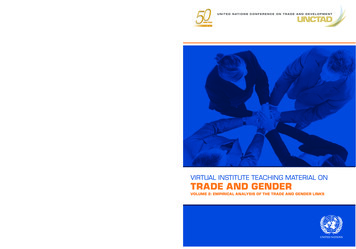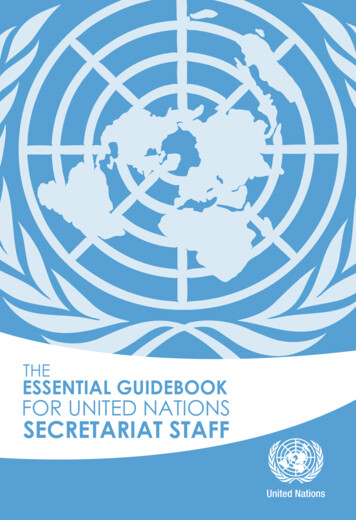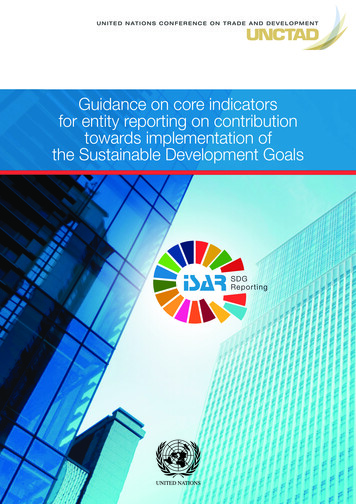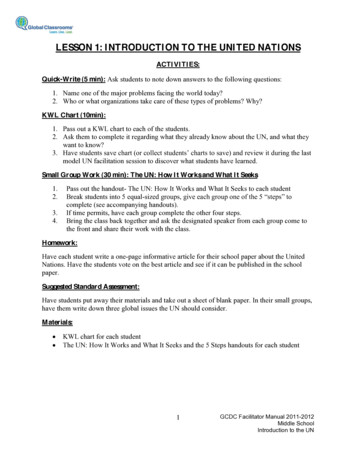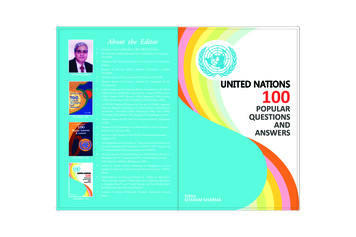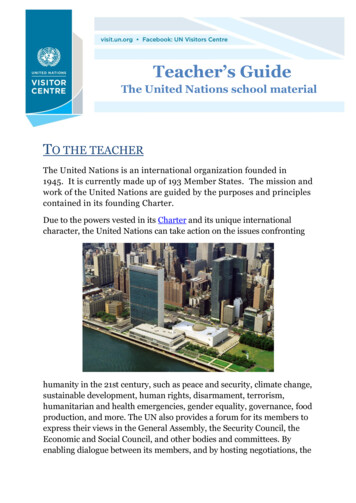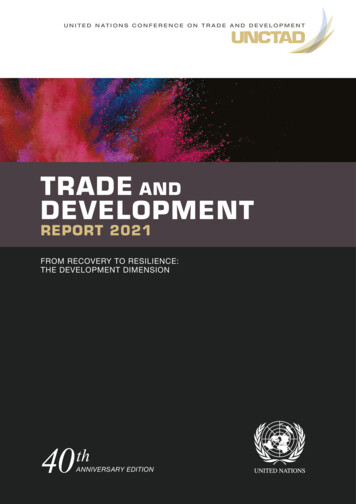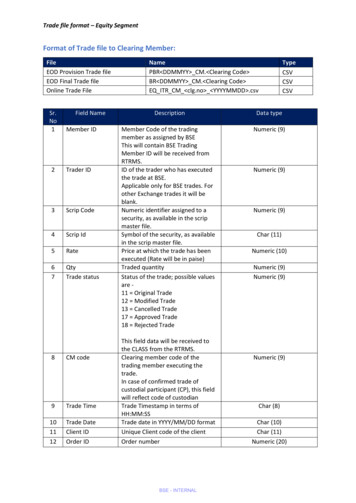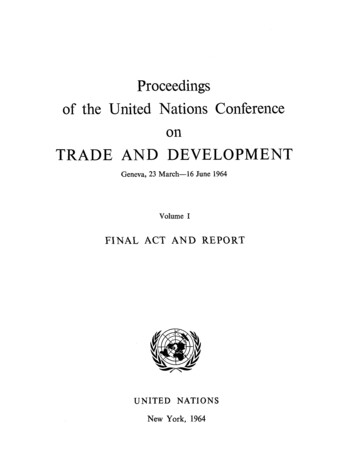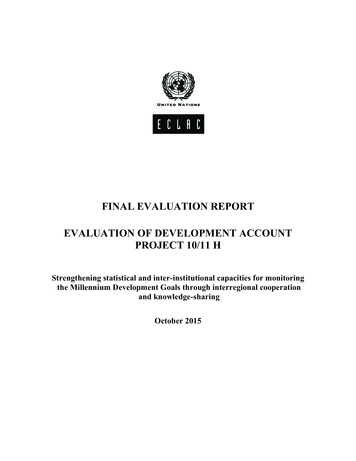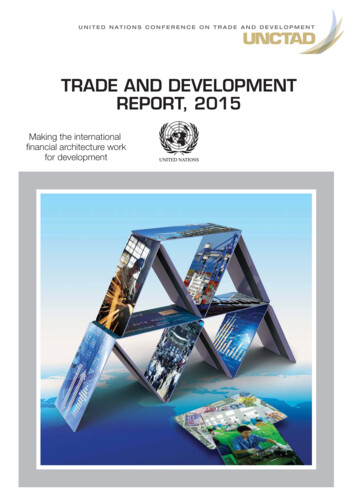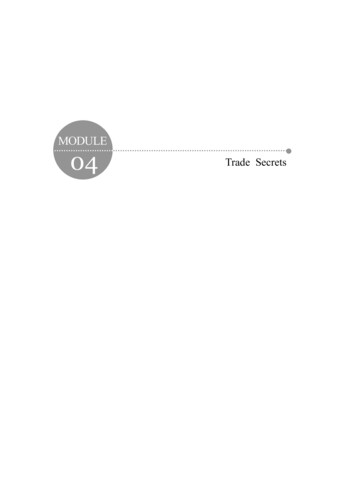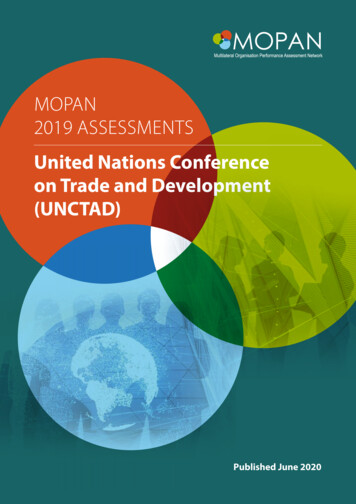
Transcription
MOPAN2019 ASSESSMENTSUnited Nations Conferenceon Trade and Development(UNCTAD)Published June 2020
For any questions or comments,please contact:The MOPAN ine.org
MOPAN AssessmentsUnited Nations Conferenceon Trade and Development(UNCTAD)2019 Performance Assessment
PREFACE . 1PrefaceABOUT MOPANThe Multilateral Organisation Performance Assessment Network (MOPAN) comprises 19 countries1 that share acommon interest in assessing the effectiveness of the major multilateral organisations they fund. These include UnitedNations agencies, international financial institutions and global funds. The Network generates, collects, analyses andpresents relevant and credible information on their organisational and development effectiveness. This knowledgebase is intended to contribute to organisational learning within and among the organisations, their direct clientsand partners, and other stakeholders. Network members use the reports for their own accountability needs and as asource of input for strategic decision-making.MOPAN 3.0, first applied in 2015-16, is the latest operational and methodological iteration of how the Networkassesses organisations. It builds on the former version, the Common Approach, which the Network implemented from2009 through 2014. In 2019, MOPAN members agreed to a change in the rating scale, with the overall frameworkunchanged. To distinguish the new approach from the initial one, the methodology applied in 2019 is called MOPAN3.0* (see Chapter 1, Introduction to this assessment).In 2019, MOPAN assessed five organisations, including the United Nations Conference on Trade and Development(UNCTAD). The other four are:l CGIARl Multilateral Fund for the Implementation of the Montreal Protocol (MLF)l United Nations Industrial Development Organisation (UNIDO)l United Nations Office for Drugs and Crime (UNODC).Operating principlesMOPAN generates assessments that are credible, fair and accurate. Credibility is ensured through an impartial,systematic and rigorous approach. MOPAN seeks an appropriate balance between coverage and depth of informationfrom a variety of sources and through multiple streams of evidence. The Network gives priority to quality of informationover quantity and uses structured tools for enquiry and analysis. An audit trail of findings ensures transparency.MOPAN applies efficient measures of assessment practice through building layers of data, with a view to limiting theburden on organisations assessed. A focus on organisational learning aims to ensure utility of the findings by multiplestakeholders.Objectives of the MOPAN methodologyMOPAN seeks to provide a diagnostic assessment, or snapshot, of an organisation. It tells the story of an organisation’scurrent performance. MOPAN is guided by framing questions which serve to understand the relevance, efficiencyand effectiveness of multilateral organisations, while also garnering a sense of the sustainability of their results. Theempirical design of MOPAN is based on a theory of change.The methodology’s key elements include a set of five performance areas against which the assessment takes place.The first four cover strategic, operational, relationship and performance management. The fifth area englobes theorganisation’s contribution to development, humanitarian and normative results. These areas are captured in the1. Australia, Belgium, Canada, Denmark, Finland, France, Germany, Ireland, Italy, Japan, Korea, Luxembourg, the Netherlands, Norway, Sweden, Switzerland, the UnitedArab Emirates, the United Kingdom and the United States.
2 . MOPAN 2019 ASSESSMENTS . UNCTADMOPAN indicator framework against which performance is measured using three evidence streams a documentreview, surveys, and interviews and consultations brought together in a combined approach.A MOPAN assessment is not an external audit of an organisation, nor is it an institutional evaluation. MOPAN does notcomprehensively assess all operations or all processes of an organisation, nor can it provide a definitive picture of allthe organisation’s achievements and performance during the time period of the assessment. Neither does MOPANoffer comprehensive documentation or analysis of ongoing organisational reform processes.AcknowledgementsThe MOPAN assessment was finalised under the overall strategic guidance of Suzanne Steensen, Head of the MOPANSecretariat. It was prepared under the responsibility of Samer Hachem, Senior Advisor, and Mitch Levine, PolicyAnalyst.The assessment was conducted with support from IOD PARC, an independent consultancy specialised in assessingperformance and managing change in the field of international development. Mark Singleton served as Team Leadfor the assessment of UNCTAD, with support from Dorothy Lucks and Jenny Geppert, under the overall leadership ofJulian Gayfer.The external partner survey was administered by Cristina Serra Vallejo from the MOPAN Secretariat, who, togetherwith Emna Ben Khedher and Miguel Bragagnolo also supported the finalisation of the report. Jill Gaston edited thereport, and Andrew Esson provided layout and graphic design.MOPAN is grateful to its Steering Committee representatives for supporting the assessment of UNCTAD. Finally,MOPAN would like to convey appreciation to UNCTAD Secretariat management and staff for their input and commentsat various stages, in particular those staff members who internally co-ordinated the process and provided substantivefeedback on the final draft report. We are particularly grateful to Ms. Isabelle Durant, Deputy Secretary-General, forher constant engagement during the assessment, and Ms. Nishta Keeble, for acting as the focal point on behalf of theUNCTAD secretariat.
TABLE OF CONTENTS . 3Table of ContentsPrefaceAcknowledgementsAcronyms and abbreviationsExecutive summary1267Chapter 1. INTRODUCTION141.1. Structure of the report141.2. UNCTAD at a glanceMission and mandateGovernanceOrganisational structureStrategyFinances1414151516161.3. Technical co-operation pillar at a glance181.4. The assessment processAssessment frameworkMethodology changes in the 2019 CycleApplying the MOPAN methodology to UNCTADLines of evidenceLimitations232324242526Chapter 2. DETAILED ASSESSMENT OF UNCTAD’s PERFORMANCE282.1. Organisational effectivenessPerformance Area: Strategic ManagementPerformance Area: Operational ManagementPerformance Area: Relationship ManagementPerformance Area: Performance Management28283235402.2. Development / humanitarian effectivenessPerformance Area: Results4444Chapter 3. OVERALL PERFORMANCE OF UNCTAD483.1. Current standing against the requirements of an effective organisationIs UNCTAD’s technical co-operation future facing?Is UNCTAD’s technical co-operation making best use of what it has?Is UNCTAD’s technical co-operation a well-oiled machine?Is UNCTAD’s technical co-operation making a difference?48484949503.2. Performance journey50
4 . MOPAN 2019 ASSESSMENTS . UNCTADAnnex 1. PERFORMANCE RATINGS AND EVIDENCE TABLE54Methodology for scoring and rating54Strategic ManagementKPI 1: Organisational architecture and financial framework enable mandate implementationand achievement expected resultsKPI 2: Structures and mechanisms in place and applied to support the implementation of globalframeworks for cross-cutting issues at all levels55Operational ManagementKPI 3: Operating model and human/financial resources support relevance and agilityKPI 4: Organisational systems are cost- and value-conscious and enable financial transparency/accountability707077Relationship ManagementKPI 5: Operational planning and intervention design tools support relevance and agility (within partnerships)KPI 6: Works in coherent partnerships directed at leveraging and/or ensuring relevance and catalytic useof resources8484556392Performance ManagementKPI 7: Strong and transparent results focus, explicitly geared to functionKPI 8: Evidence-based planning and programming applied102102108ResultsKPI 9: Development and humanitarian objectives are achieved, and results contribute to normative andcross-cutting goalsKPI 10: Interventions are relevant to the needs and priorities of partner countries and beneficiaries, andthe organisation works towards results in areas within its mandateKPI 11: Results delivered efficientlyKPI 12: Sustainability of results118Annex 2. LIST OF DOCUMENTS135Annex 3. RESULTS OF THE 2019 MOPAN’S EXTERNAL PARTNER SURVEY142StaffingInterventions (programmes, projects and normative work)Interventions (cross-cutting issues and familiarity)Interventions (cross-cutting issues and organisational performance)Managing relationshipsPerformance managementEvidence base for planning and programming143143145145146148149118126130132
TABLE OF CONTENTS . 5Boxes and figuresBox 1.1: Preventing sexual exploitation and abuse, and sexual harassmentBox 1.2: The ASYCUDA programmeBox 1.3: The DMFAS programmeBox 1.4: The Angola Train for Trade II projectBox 1.5: Performance areas and key performance indicatorsBox 3.1: Main strengths identified in the MOPAN 2019 assessment of technical co-operationBox 3.2: Main areas of improvement identified in the MOPAN 2019 assessment of technical co-operation17192021235252Figure 1.1: Contribution to UNCTAD Trust Funds, 2009-19Figure 1.2: Technical co-operation expenditures by funding source, 2014-18Figure 2.1: Cross-cutting issuesFigure 2.2: Staff performanceFigure 2.3: Operational planning and intervention designFigure 2.4: PartnershipsFigure 2.5: Results-based managementFigure 2.6: Implementation and use of evaluations2222313437394143
6 . MOPAN 2019 ASSESSMENTS . UNCTADAcronyms and FAOGEEWGEWEHQHRIATIIMDISJIUKPILDCLLDCDivision for Africa, Least Developed Countriesand Special ProgrammesAutomated System for Customs DataDivision on Globalisation and DevelopmentStrategiesDivision on Investment and EnterpriseDivision on International Trade andCommoditiesDebt Management and Financial AnalysisSystemDeputy Secretary-GeneralDivision on Technology and LogisticsEvaluation and Monitoring UnitFood and Agriculture OrganisationGender Equality and the Empowermentof WomenGender Equality and Women’s EmpowermentHeadquartersHuman resourcesInternational Aid Transparency InitiativeIntegrated Monitoring and DocumentInformation SystemJoint Inspection Unit of the United NationsKey performance indicatorLeast developed countryLandlocked developing countryMIMOPANMicro-indicatorMultilateral Organisation PerformanceAssessment NetworkOIOSUN Office of Internal Oversight ServicesOSGOffice of the Secretary-GeneralRBRegular budgetRBMResults-based managementRMSResources Management ServiceSDGSustainable Development GoalSEAHSexual exploitation and abuse, and sexualharassmentSIDSSmall island developing stateTCTechnical co-operationTCSTechnical Cooperation SectionTDBTrade and Development BoardUNUnited NationsUN Women United Nations Entity for Gender Equality andthe Empowerment of WomenUNCTAD United Nations Conference on Trade andDevelopmentUNDAFUnited Nations Development AssistanceFrameworkUNEGUnited Nations Evaluation GroupUN-SWAP UN System-wide Action PlanXBExtrabudgetary
EXECUTIVE SUMMARY . 7Executive summaryIn 2019, the Multilateral Organisation Performance Assessment Network (MOPAN) assessed the technical co-operationpillar of the United Nations Conference on Trade and Development (UNCTAD). In accordance with the agreementreached between MOPAN and the Secretary-General of UNCTAD, and at the request of the Group of 77 and China, theconsensus-building pillar and the research and analysis pillar have been left out of the scope of the assessment. Thisis the first MOPAN assessment of UNCTAD.The assessment addresses organisational systems, practices and behaviours pertinent to technical co-operation (TC),as evident within and pertaining to the snapshot period of January 2017 to mid-2019. The MOPAN scoring and ratingsystem for organisational effectiveness (Key performance indicators [KPIs] 1-8) has been applied to the TC pillar only,in accordance with the adjusted scope of the assessment. For organisational results (KPIs 9-12), no rating or scoringwas applied, as UNCTAD’s results are a composite of all three pillars: technical co-operation, research and analysis, andconsensus building. Instead, the report narrates themes and challenges relating to TC results emerging from externalindependent evaluations, audits and reviews from 2013 till late-2019.It should be noted that findings from this assessment, including at a programme and project level, are only valid withinthe technical co-operation (TC) pillar. The two other pillars of UNCTAD, while interlinked with technical co-operation,do not function in the same way and have not been subject to any form of review by MOPAN, in the context of thisassessment. To extend an opinion of TC effectiveness across the organisation would therefore be inappropriate.CONTEXTIn 1964, the United Nations (UN) General Assembly established UNCTAD as one of its subsidiary organ. Theorganisation’s mission is to promote international trade, especially with a view to accelerating economic development,particularly of developing countries, as well as to promote policy analysis, facilitate consensus building and offertechnical co-operation. UNCTAD is mandated to assist developing countries and countries with economies intransition in integrating beneficially into the global economy, in support of inclusive and sustainable growth anddevelopment. UNCTAD fulfils this mandate through three closely interlinked functions or pillars: (i) providing a forumfor intergovernmental deliberations (the consensus-building pillar); (ii) undertaking research, policy analysis and datacollection to inform these deliberations (the research and analysis pillar); and (iii) providing technical assistance todeveloping countries.The UNCTAD secretariat is an entity within the UN Secretariat. It reports to the UN General Assembly and the Economicand Social Council but has its own separate governing body, the Trade and Development Board, a permanentsubsidiary organ of UNCTAD. Structurally, the UNCTAD secretariat operates under UN Secretariat regulations andrules, management frameworks, and processes. UNCTAD is a non-resident agency.UNCTAD is an entity driven by member states. Its mandate is negotiated and agreed during its quadrennial conferences,where member states convene, discuss and set the priorities for the next four years across a vast and growing set oftrade and development challenges. The mandate is then operationalised and implemented between conferences. TheNairobi Maafikiano is the name given to the outcome document adopted at the 14th session of UNCTAD. The secretariatis funded through the UN regular budget. In addition, UNCTAD’s TC activities are financed through (i) extrabudgetarycontributions for trust funds (90.4% of total extrabudgetary funding); and (ii) the UN Regular Programme of TechnicalCooperation, the UN Development Account, and “Delivering as One” trust funds (9.6%).
8 . MOPAN 2019 ASSESSMENTS . UNCTADKEY FINDINGSUNCTAD is strongly committed to implementing its mandate to support the least developed countries and economiesin transition in the realm of trade and development. UNCTAD is one of few organisations within the UN with robust andin-depth expertise on trade and development issues and on how these impact developing countries and countriesin transition.UNCTAD’s technical co-operation is an integral part of the organisation and interlinked with its two other pillars.Drawing on robust economic data and analysis, UNCTAD’s knowledge, expertise and technical assistance are viewedpositively by member states. Generally speaking, national ownership is strong. UNCTAD enjoys solid support frommember states for its TC products not only the major programmes ASYCUDA2 and DMFAS,3 but also others suchas e-commerce and the digital economy, trade and transport facilitation, and business and investment facilitation.These interventions have demonstrated positive results, and the fact that many have become (partly) self-financed isevidence of strong performance.Within UNCTAD, technical co-operation is de facto decentralised. Divisions, branches and sections have autonomy toengage with partners, mobilise resources and implement activities. Consequently, different operating models at thedivisional level have evolved over time and co-exist alongside each other, with the Technical Cooperation Section ofthe Office of the Secretary-General (OSG) more in an enabling than a steering capacity. The operating model doesnot actively encourage more strategic internal and external co-ordination. Instead, much is left to staff members’individual networks. While this may create opportunities and responsiveness at a project, programme or section level,it also obscures vision and strategic approaches.Due to a lack of consensus among member states, the last time UNCTAD’s corporate TC strategy was formally adoptedwas in 2003. At present, UNCTAD lacks an up-to-date corporate TC strategy, comprehensive TC oversight mechanismsand other tools, such as a TC fundraising strategy, and a TC external relations and partnerships strategy. Constrainedby human and financial resources, but also by a lack of prioritisation, UNCTAD’s technical co-operation is unable tomeet growing demand in various innovative “high potential” areas.Because UNCTAD is a member states-driven organisation, and because of the different contexts and dynamics ofits member states, demand for UNCTAD’s technical co-operation is becoming increasingly diverse. While efforts tostreamline and prioritise these products may meet approval from some member states, others may resist, pointingto their particular needs. Thus, prioritising certain products over others has proven challenging, causing furtherfragmentation of the TC portfolio. Meanwhile, TC implementation depends first and foremost on the availability ofextrabudgetary funding. The leadership is navigating between different interests, externally as well as internally.External risks as well as opportunities to reposition UNCTAD, build strategic partnerships and strengthen its nichehave so-far not triggered secretariat-wide strategic responses.The assessment identifies three strengths of UNCTAD’s technical co-operation:1. UNCTAD is one of few agencies mandated to address trade and development. It provides relevant, specificexpertise that would otherwise not be easily available to its prioritised member states, the least developedcountries. Its staff are dedicated to UNCTAD’s mandate.2. The Automated System for Customs Data (ASYCUDA) programme is an integrated customs management system for international trade and transport operations ina modern automated environment.3. The Debt Management and Financial Analysis System (DMFAS) programme provides technical co-operation and advisory service in the area of debt management.
EXECUTIVE SUMMARY . 92. UNCTAD is highly regarded by its development partners. Member states’ governments appreciate UNCTAD’ssincerity and responsiveness to their demands and needs, as is witnessed through the sometimes decades-longrelationships in TC delivery. Besides constantly updating and innovating its longstanding programmes ASYCUDA,DMFAS and others, UNCTAD is also adding valuable contributions to innovative TC niche areas, such as e-commerceand the digital economy, bio-trade, and financing for development.3. Generally, UNCTAD’s technical co-operation interventions are regarded as relevant, effective, efficient andsustainable. UNCTAD delivers results that contribute towards institutional and policy change and engages withpartners to encourage the uptake of TC support. Working with a relatively small TC budget, UNCTAD has provento be cost-efficient in most areas, thanks to its careful management of available funds and tight financial control.The assessment also finds three major areas for improvement:1. Two main programmes, ASYCUDA and DMFAS represent close to 60% of UNCTAD’s technical co-operation,but the remainder is highly fragmented. This has evolved autonomously as a consequence of the de factodecentralised operating model. Because oversight is conducted at the divisional level, rather than the secretariatlevel, strategic corporate-level co-ordination and decision-making for technical co-operation is implicit, ratherthan systematic and robust. Tools and mechanisms for such co-ordination are in place but not used to their fullpotential.2. There is a growing mismatch between member states’ demands and UNCTAD’s supply capabilities. Anexplanatory factor is the absence of a secretariat-wide, integrated, future-facing technical co-operation strategythat sets the direction for fundraising, partnership and external relations, and could support prioritisation acrossthe secretariat.3. Until recently, results-based management was largely missing at the outcome level for technical co-operation.Although important steps have been taken to enhance results-based management, within UNCTAD’s TC pillarthere is no holistic approach to tracking performance, identifying poor performance or overseeing deviations fromplanned results in TC interventions. Cross-cutting themes are only partially addressed.METHODS OF ANALYSISThe MOPAN 3.0* methodology entails a framework of 12 key performance indicators and associated micro-indicators.It comprises standards that characterise an effective multilateral organisation. The methodology, including recentupdates and any adaptations for this particular assessment, is further explained in Section 1.4 of this report.The assessment of performance covers UNCTAD’s headquarters and regional and country field presence. As mentionedabove, it addresses organisational systems, practices and behaviours pertinent to technical co-operation during theperiod January 2017 to mid-2019. It relies on three lines of evidence: a review of 187 selected documents out of a totalof 561 recorded documents (some dating back to 2013), interviews with 69 staff members at UNCTAD’s headquartersin Geneva and remote interviews with staff based in New York and Addis Ababa carried out between Septemberand November 2019, and 65 responses to the external partners survey carried out among external partners in 12countries between mid-October and early November 2019.MOPAN conducted the assessment with support from IOD PARC, a consulting company located in the United Kingdomthat specialises in results-based performance assessment in international development.
10 . MOPAN 2019 ASSESSMENTS . UNCTAD6.9 Knowledgessments6.Works inse6.8 Joint asORGANISATIONALPERFORMANCEedpey5.1 AlignmentmanRiskapacity analysis5.2 Context analysisment5.3 Cagess Croingten5.5entatioobilisationakstainrce mmmrseSu3.2 Resouonm3.1 Resources aligned tofunctionisi5.6rights2.1d Human3.3dec Deceisio ntran m liseaki d3.nghu 4 Pem rfoan rmre ansour ce-bce D4.4.24.3atitern4.4 Introl mec4.5 Con5.7entnmiroEnv2.1c3.Operating modeland resourcessupport, relevanceand agility4.Cost and valueconsciousness,financialtransparency4.6 Anti-fraud proceduishionlatRemanagement1.2 Organisational architectu1.3reSuframe pportwonrks orm1.4ativfra Finem anew cior a lks2.Cross-cuttingissuesriescoherentneficiay to beringntabilituapartnershipsohccson6.7 Atian5.formatio6.6 Inrdinso-oOperationalrgieer csyneartnPSplanning andem6.56.4ysteysintervention and agility6.36.ratiampCo6.2pb2.1lnaioteraOpHow to read these chartsMicro-indicator47.1 RBM appliedndGe1.3rategiesera2.11.7.Strong andtransparent resultsfocus, explicitlygeared to functionM in st1.Organisationalarchitectureand financialframework1.1targetsdChanges to MOPANrating system(MOPAN 3.0* scales)The 2019 Assessment Cycleunder MOPAN 3.0* includes anotable change on how ratings(and their correspondingcolours) are applied basedon the scores at MI and KPIlevel. Compared to previouscycles, the threshold for arating has been raised to reflectthe increasing demands fororganisational performancein the multilateral system.The underlying scores andapproach to scoring areunaffected. Further informationcan be found in Chapter 1,Section 1.4 Methodologychanges in the 2019 Cycle.1.2sedgsystems8.Evidence-basedplanning andprogrammingappliedlie1.1 Long-termPerformance7.2 Perfo8.7 Uptake of lessons8.38.27.57.47.3stemsw-up sy8.6 Folloedtracka nceerformsignoor pd de8.5 emgaanmvisionPERFORMANCE RATING SUMMARY FOR UNCTAD(MOPAN 3.0 – old rating scale system)11.51.61.7Key Performance IndicatorHighly tisfactory(1.01-2.00)Highly unsatisfactory(0-1.00)No evidence /Not applicable
EXECUTIVE SUMMARY . 11Evidence-baito7.2 ning andprogrammingappliedlied7.Strong andtransparent resultsfocus, explicitlygeared to functionM in strategies7.1 RBM appliededype5.1 Alignmentnguttiss cman5.4RiskCroagemen5.3 Ctapacity analysis5.2 Context analysisilitnsabSustain5.5entatio5.6mpleIm3.1 Resources aligned tofunction3.2 Resource mingak5.7rights2.1d ecgetinudgdastan1.1ce2.1c3.3dec Deceisio ntran m liseaki d3.4nghu Pem rfoan rmre ansour ce-bce asesdbuDisdbase1.2iroEnv1D4.4.2auditNo evidence /Not applicablets-bHighly 0)4.3Satisfactory(2.51-3.50)sHighly satisfactory(3.51-4.00)bonalKey Performance Indicatorhanism1.7atitern4.4 In1.6entnm2.14.Cost and 3.Operating modeland resourcessupport, relevanceand agilityctrol me4.5 RFORMANCE4.6 Anti-fraud procedishionlatReHow to read these chartserdenG.1a2.Cross-cuttingissues6.9 Knowledge6.sessmentsWorks in6.8 Joint assericiacoherentbenefibility toingpartnershipscountasharno6.7 Acatin5.formatio6.6 InrdinOperationaliesco-ogrreetnsParSynplanning and6.5tem6.4esysyintervention designtag ytrnnaouilitsupport, relevancedvecAgeaUs.1tivand and reSfra uppmeortwonorrksma1.tivefra 4 Finm anew cior alksan1.1 Long-termPerformancevem1.2 OrganisatirmEffectiStrategicmtenemaganPerfo8.7 Uptake of lessons8.27.57.47.3stemsw-up sy8.6 Follockede tramancerforsignoor pd de8.5 ING SUMMARYFOR UNCTAD(MOPAN 3.0* –new rating scalesystem)lnaioteraOp
1. INTRODUCTION
14 . MOPAN 2019 ASSESSMENTS . UNCTADChapter 1. Introduction1.1. STRUCTURE OF THE REPORTThis report assesses the technical co-operation (TC) pillar of the United Nations Conference on Trade and Development(UNCTAD). In accordance with the agreement reached between MOPAN and the Secretary General of UNCTAD, andat the request of the Group of 77 and China, the consensus-building pillar, the research and analysis pillar, and theUNCTAD governance structure have been left out of the scope of the UNCTAD MOPAN assessment process. Given thatUNCTAD’s three pillars form an organic whole and are inherently interlinked, for the purposes of understanding thecontext in which the organisation operates, the assessment team considered, but did not assess, the intergovernmentalmachinery and the research and analysis pillar.The assessment of organisational effectiveness covers UNCTAD’s headquarters and regional and country fieldengagement. It addresses organisational systems, practices and behaviours pertinent to technical co-operation, asevident within and pertaining to the snapshot period of January 2017 to mid-2019. The MOPAN scoring and ratingsystem for organisational effectiveness (Key performance indicators [KPIs] 1-8) has been applied, in accordance withthe adjusted scope of the assessment.This report has three chapters and three annexes. Chapter 1 introduces UNCTAD and the assessment process.Chapter 2 presents the main findings of the assessment in relation to each performance area. Chapter 3 provides theconclusions of the assessment. Annex 1 summarises the evidence gathered against each indicator with the detailedscores, where relevant. Annex 2 lists the documents used for the analysis. Finally, Annex 3 provides an overview of theresults of MOPAN’s partner survey.1.2. UNCTAD AT A GLANCEMission and mandate: Established by the United Nations General Assembly in 1964,4 UNCTAD is a subsidiary organof the General Assembly. Its mission is to promote international trade, especially with a view to accelerating economicdevelopment, particularly of developing countries, as well as to provide policy analysis, facilitate consensus buildingand offer technical cooperation. It does so through informing national and international policies, while giving priorityconsideration for the needs and interests of developing countries. Within the United Nations (UN) system, it is the focalpoint for the integrated treatment of trade and interrelated issues in the areas of investment, finance and technologyas key drivers of the inclusive, equitable global economic environment for sustainable development.5UNCTAD is responsible for assisting developing countries, especially the least developed countries (LDCs), andcountries with economies in transition in integrating beneficially into the global economy, in support of inclusiveand sustainable growth and development. Its mandate derives from the priorities established in relevant GeneralAssembly resolutions and decisions, including the quadrennial sessions of UNCTAD.UNCTAD is mandated6 to “strategically position itself by applying three principles: comparative advantage;differentiation of its wo
3.1. Current standing against the requirements of an effective organisation 48 Is UNCTAD's technical co-operation future facing? 48 Is UNCTAD's technical co-operation making best use of what it has? 49 Is UNCTAD's technical co-operation a well-oiled machine? 49 Is UNCTAD's technical co-operation making a difference? 50 3.2. Performance .
